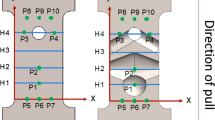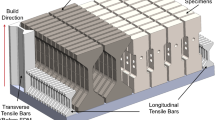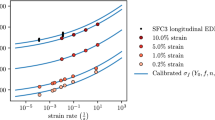Abstract
Within the scope of the third Sandia Fracture Challenge the plasticity and ductile fracture behavior of an additively manufactured 316L stainless steel tensile specimen containing through holes and internal cavities is predicted in a blind round robin format. Only a limited number of experimental results, including flat dogbone-shaped and double-notch tension specimens, as well as EBSD maps of the Challenge geometry are provided by Sandia National Laboratory. A non-associated Hill’48 plasticity model with Swift-Voce strain hardening and Johnson–Cook strain rate hardening is used to accurately describe the large deformation response of the material. A special case of the recently developed Hosford–Coulomb model is used to predict fracture initiation and propagation by crack re-initiation. Very good qualitative and quantitative agreement of the blind prediction with the experimental results is obtained for both global force-displacement responses as well as the local surface strain evolution throughout the test. In a post challenge follow-up study, the role of the plasticity model is evaluated, focusing on the effect of the anisotropy and the strain-rate on the material response. Aside from considering the deterministic model, the statistical material properties of the additively manufactured structure are analyzed by defining a heterogeneous random media model. Probabilistic material properties for both plasticity and fracture are assigned to each element of the Challenge specimen. As an alternative, the role of intrinsic porosities is analyzed by randomly deleting 1% of the pristine geometry. The results of both approaches show that the presence of homogeneities follows a more realistic description of the material behavior, especially in the crack propagation regime post maximum force and when looking at local strains.



















Similar content being viewed by others
References
Agarwala M, Bourell D, Beaman J, Marcus H, Barlow J (1995) Direct selective laser sintering of metals. Rapid Prototyp J 1(1):26–36
Bai Y, Wierzbicki T (2010) Application of extended Mohr-Coulomb criterion to ductile fracture. Int J Fract 161(1):1
Barlat F, Brem JC, Yoon JW, Chung K, Dick RE, Lege DJ, Pourboghrat F, Choi SH, Chu E (2003) Plane stress yield function for aluminum alloy sheets–part 1: theory. Int J Plast 19(9):1297–1319
Beese AM, Carroll BE (2016) Review of mechanical properties of Ti–6Al–4V made by laser-based additive manufacturing using powder feedstock. JOM 68(3):724–734
Beese AM, Wang Z, Stoica AD, Ma D (2018) Absence of dynamic strain aging in an additively manufactured nickel-base superalloy. Nat Commun 9(1):2083
Bhavar V, Kattire P, Patil V, Khot S, Gujar K, Singh R (2014) A review on powder bed fusion technology of metal additive manufacturing. In: 4th International conference and exhibition on additive manufacturing technologies-AM-2014, September, pp 1–2
Boyce BL, Kramer SL, Fang HE, Cordova TE, Neilsen MK, Dion K, Kaczmarowski AK, Karasz E, Xue L, Gross AJ, Ghahremaninezhad A (2014) The Sandia Fracture Challenge: blind round robin predictions of ductile tearing. Int J Fract 186(1–2):5–68
Boyce BL, Kramer SLB, Bosiljevac TR, Corona E, Moore JA, Elkhodary K, Simha CHM, Williams BW, Cerrone AR, Nonn A, Hochhalter JD (2016) The second Sandia Fracture Challenge: predictions of ductile failure under quasi-static and moderate-rate dynamic loading. Int J Fract 198(1–2):5–100
Brackett D, Ashcroft I, Hague R (2011) August. Topology optimization for additive manufacturing. In: Proceedings of the solid freeform fabrication symposium, Austin, TX, Vol. 1, pp. 348–362
Bremen S, Meiners W, Diatlov A (2012) Selective laser melting: a manufacturing technology for the future? Laser Technik J 9(2):33–38
Erice B, Roth CC, Mohr D (2018) Stress-state and strain-rate dependent ductile fracture of dual and complex phase steel. Mech Mater 116:11–32
Foust M, Thomsen D, Stickles R, Cooper C, Dodds W (2012) Development of the GE aviation low emissions TAPS combustor for next generation aircraft engines. In: 50th AIAA aerospace sciences meeting including the new horizons forum and aerospace exposition
Gong H, Rafi K, Gu H, Starr T, Stucker B (2014) Analysis of defect generation in Ti–6Al–4V parts made using powder bed fusion additive manufacturing processes. Addit Manuf 1:87–98
Gorji MB, Manopulo N, Hora P, Barlat F (2016) Numerical investigation of the post-necking behavior of aluminum sheets in the presence of geometrical and material inhomogeneities. Int J Solids Struct 102:56–65
Gorji MB, Tancogne-Dejean T, Mohr D (2018) Heterogeneous random medium plasticity and fracture model of additively-manufactured Ti–6Al–4V. Acta Mater 148:442–455
Gu D, Hagedorn YC, Meiners W, Meng G, Batista RJS, Wissenbach K, Poprawe R (2012) Densification behavior, microstructure evolution, and wear performance of selective laser melting processed commercially pure titanium. Acta Mater 60(9):3849–3860
Gurson AL (1977) Continuum theory of ductile rupture by void nucleation and growth: part I-Yield criteria and flow rules for porous ductile media. J Eng Mater Technol 99(1):2–15
Herderick ED (2017) Accelerating the additive revolution. JOM 69(3):437–438
Hill R (1948) A theory of the yielding and plastic flow of anisotropic metals. Proc R Soc Lond A 193(1033):281–297
Hosford WF (1972) A generalized isotropic yield criterion. J Appl Mech 39(2):607–609
Johnson GR, Cook WH (1985) Fracture characteristics of three metals subjected to various strains, strain rates, temperatures and pressures. Eng Fract Mech 21(1):31–48
Khaing MW, Fuh JYH, Lu L (2001) Direct metal laser sintering for rapid tooling: processing and characterisation of EOS parts. J Mater Process Technol 113(1–3):269–272
King WE, Anderson AT, Ferencz RM, Hodge NE, Kamath C, Khairallah SA, Rubenchik AM (2015) Laser powder bed fusion additive manufacturing of metals; physics, computational, and materials challenges. Appl Phys Rev 2(4):041304
Kramer SLB, Boyce BL, Jones A, Mostafa A, Ravaji B, Tancogne-Dejean T, Roth CC, Gorji MB, Pack K, Foster JT, Behzadinasab M, Sobotka JC, McFarland JM, Stein J, Spear AD, Newell P, Czabaj MW, Williams BW, Simha CM, Gesing M, Gilkey LN, Jones CA, Dingreville R, Sanborn SE, Bignell JL, Cerrone A, Keim V, Nonn A, Cooreman S, Thibaux P, Ames N, O’Connor DT, Parno MD, Davis B, Tucker J, Coudrillier B, Karlson KN, Ostien JT, Foulk III JW, Hammetter CI, Grange S, Emery JM, Brown JA, Bishop JE, Johnson KL, Ford KR, Brinckmann S, Neilsen MK, Jackiewicz J, Ravi-Chandar K, Ivanoff TA, Salzbrenner BC (2019) The third Sandia Fracture Challenge: predictions of ductile fracture in additively manufactured metal. Int J Fract
Lemaitre J (1985) A continuous damage mechanics model for ductile fracture. J Eng Mater Technol 107(1):83–89
Matthews MJ, Guss G, Khairallah SA, Rubenchik AM, Depond PJ, King WE (2016) Denudation of metal powder layers in laser powder bed fusion processes. Acta Mater 114:33–42
McClintock FA (1968) A criterion for ductile fracture by the growth of holes. J Appl Mech 35(2):363–371
Mohr D, Marcadet SJ (2015) Micromechanically-motivated phenomenological Hosford-Coulomb model for predicting ductile fracture initiation at low stress triaxialities. Int J Solids Struct 67:40–55
Mohr D, Dunand M, Kim KH (2010) Evaluation of associated and non-associated quadratic plasticity models for advanced high strength steel sheets under multi-axial loading. Int J Plast 26(7):939–956
Murr LE, Gaytan SM, Ramirez DA, Martinez E, Hernandez J, Amato KN, Shindo PW, Medina FR, Wicker RB (2012) Metal fabrication by additive manufacturing using laser and electron beam melting technologies. J Mater Sci Technol 28(1):1–14
Nahshon K, Hutchinson JW (2008) Modification of the Gurson model for shear failure. Eur J Mech A Solids 27(1):1–17
Pack K, Luo M, Wierzbicki T (2014) Sandia Fracture Challenge: blind prediction and full calibration to enhance fracture predictability. Int J Fract 186(1–2):155–175
Pack K, Roth CC (2016) The second Sandia Fracture Challenge: blind prediction of dynamic shear localization and full fracture characterization. Int J Fract 198(1–2):197–220
Rafi HK, Karthik NV, Gong H, Starr TL, Stucker BE (2013) Microstructures and mechanical properties of Ti–6Al–4V parts fabricated by selective laser melting and electron beam melting. J Mater Eng Perform 22(12):3872–3883
Rice JR, Tracey DM (1969) On the ductile enlargement of voids in triaxial stress fields*. J Mech Phys Solids 17(3):201–217
Roth CC, Mohr D (2014) Effect of strain rate on ductile fracture initiation in advanced high strength steel sheets: experiments and modeling. Int J Plast 56:19–44
Roth CC, Mohr D (2016) Ductile fracture experiments with locally proportional loading histories. Int J Plast 79:328–354
Salzbrenner BC, Rodelas JM, Madison JD, Jared BH, Swiler LP, Shen YL, Boyce BL (2017) High-throughput stochastic tensile performance of additively manufactured stainless steel. J Mater Process Technol 241:1–12
Stoughton TB (2002) A non-associated flow rule for sheet metal forming. Int J Plast 18(5–6):687–714
Sun Z, Tan X, Tor SB, Yeong WY (2016) Selective laser melting of stainless steel 316L with low porosity and high build rates. Mater Des 104:197–204
Swift H (1952) Plastic instability under plane stress. J Mech Phys Solids 1(1):1–18
Tancogne-Dejean T, Roth CC, Woy U, Mohr D (2016) Probabilistic fracture of Ti–6Al–4V made through additive layer manufacturing. Int J Plast 78:145–172
Tvergaard V, Needleman A (1984) Analysis of the cup-cone fracture in a round tensile bar. Acta Metall 32(1):157–169
Voce E (1948) The relationship between stress and strain for homogeneous deformation. J Inst Metals 74:537–562
Wang YM, Voisin T, McKeown JT, Ye J, Calta NP, Li Z, Zhu T (2017) Additively manufactured hierarchical stainless steels with high strength and ductility. Nat Mater 17:63
Zegard T, Paulino GH (2016) Bridging topology optimization and additive manufacturing. Struct Multidiscipl Optim 53(1):175–192
Acknowledgements
The authors would like to thank Prof. Dirk Mohr (ETH) and Prof. Tomasz Wierzbicki (MIT) for fruitful discussions. The MIT fracture consortium is thanked for partial financial support.
Author information
Authors and Affiliations
Corresponding author
Additional information
Publisher's Note
Springer Nature remains neutral with regard to jurisdictional claims in published maps and institutional affiliations.
Rights and permissions
About this article
Cite this article
Tancogne-Dejean, T., Gorji, M.B., Pack, K. et al. The third Sandia Fracture Challenge: deterministic and probabilistic modeling of ductile fracture of additively-manufactured material. Int J Fract 218, 209–229 (2019). https://doi.org/10.1007/s10704-019-00355-z
Received:
Accepted:
Published:
Issue Date:
DOI: https://doi.org/10.1007/s10704-019-00355-z




